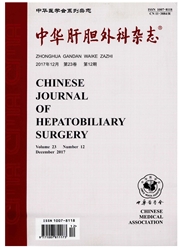

 中文摘要:
中文摘要:
目的研究肝移植手术中供体肝组织缺血一再灌注损伤的蛋白质变化规律。方法2009年3月,对3例肝移植供肝于3个时间点切取肝组织标本进行对照研究:(1)新鲜的供肝组织;(2)经过缺血降温保存后修整完毕,但未经血管吻合的肝脏组织;(3)复流后的供肝组织。通过2DEMALDI—TOF和质谱技术,对上述3个时间点的蛋白表达作出比较。结果本研究共分离出1580个蛋白点,其中与缺血再灌注损伤有关的蛋白19个。结合19个蛋白质的功能,对这些蛋白质的变化特征进一步分析。结论我们发现了与肝移植手术中供肝缺血性损伤和再灌注损伤相关的蛋白质,并首次揭示了这些蛋白质在不同损伤阶段独立的变化规律。
 英文摘要:
英文摘要:
Objective To identify the proteins presented variation during ischemia/reperfusion injury (I/RI) in liver transplantation (LT). Methods At Mar. 2009, a total of nine liver sample tissues, three samples obtained from each donor liver at three different time points, were studied. The time points were as follows: (1) the time point immediately after donor liver was harvested (T1) ; (2) the time point just before the anastomosis of hepatic artery and potal vein (T2), during this time period the donor liver was kept in ice cold and transported, then back-table prepared, during time from T1 to T2, ischemia injury occurred; (3) the time after donor reconnected to the recipient (T3), during which the donor liver was subjected to reperfusion iniury. The three time points represent normal control, ischemia injury, and reperfusion injury respectively. By using method of 2DE-MALD1-TOF and mass-spectrum, the differential expression of these protein at T1, T2, and T3 time point were compared. Results From the 1580 proteins that were isolated, 19 ischemia/reperfusion injury (I/RI)-related proteins that varied markedly from time point T1 to T2 and from time point T2 to T3 were identified. They were metabolic enzyme, molecular chaperone, redoxase, cytoskeleton protein, signal transduction protein, and binding protein, respectively. The character of each protein was further analized based on their functions. Conclusions For the first time, we detected the protein related to I/RI during LT. We obtained independent proteomics information of ischemia injury, and reperfusion injury, respectively. Further functional analyses of these proteins may improve the understanding of the critical biological processes during I/RI. Medicine intervention on the I/RI-related proteins may result in improved survival of the recipients.
 同期刊论文项目
同期刊论文项目
 同项目期刊论文
同项目期刊论文
 期刊信息
期刊信息
